

by Galen Berry
Vienna, Austria -- the City of Music. More great composers have lived here than anywhere else in the world, by far -- this was the city of Beethoven, Mozart, Schubert, Brahms, Haydn, Mahler, Bruckner, Liszt, Schönberg, and all the Strausses... Johann, Joseph, and Richard; not to mention dozens of lesser-known names like Lehár, Ziehrer, Berg, Webern, Lanner, Korngold, and Von Suppé. This is where waltzing became such a wild fad in the mid-1800's, that a grand dance ball could be found somewhere in the city every night of the year for decades. This prompted one city official to answer once, when asked how things were going in Vienna, "Hopeless, but not serious."
And few cities have had as much music written about them as Vienna, either... one of the best-known songs in honor of the city is "Vienna, City of my Dreams"... click here to hear it sung beautifully by the great German tenor, Fritz Wunderlich.
And Vienna is a dream of a city. Year after year, it gets ranked as the "world's most livable city". It was chosen as the European seat of the United Nations. It has more business conventions than any other city in the world. It is situated on the beautiful blue Danube (which is brown). And, architecturally, no other city matches it in grandeur except Paris. The single most incredible street in the world for grandiose architecture is Vienna's great Ringstraße, or Ring Street.
Vienna's magnificence is all out of proportion to the size of its country. A first-time visitor often wonders: how did this rather small, insignificant, polliwog-shaped country manage to get such a glorious capital city? One look around the city immediately tells you that Austria must have once been a vastly more important place than it is now. And so it was. Few realize nowadays that at one time, Austria was the richest, most powerful country in the world. In Europe, it was second in size and population only to Russia.
Austria was an empire, not merely a kingdom, meaning it had an emperor as its ruler, not merely a king. One would think that a king would be the ultimate form of a ruler, but no... an emperor is a king of kings. The Emperor of Austria had authority over the kings and rulers of Hungary, Bosnia, Croatia, Bohemia, Slovakia, Slovenia, Montenegro, Poland, Romania, Serbia, Albania, and Ukraine. He was even considered to be the King of Jerusalem.
Vienna was the largest German-speaking city in the world for centuries, until Berlin finally surpassed it. Their own German word for Vienna is "Wien"... a rare case of where the English version of a place sounds a lot better than the original! (For that matter, their own word for "Austria" is "Österreich", a guttural word containing three sounds that don't even exist in English.) The adjective version of the word Wien is "wiener" -- so any person or thing (or sausage) that comes from Wien is a wiener. (Just like something from Hamburg, Germany is a hamburger, or from Frankfurt is a frankfurter.) If a person from Berlin can say, "Ich bin ein Berliner", then a person from Vienna can say, "Ich bin ein Wiener!"
Well, for two weeks, I too was proud to be a Wiener. (Okay, Viennese.) For once, I decided not to do my usual crazy style of travel, meaning renting a car and driving thousands of miles through a dozen different countries. This time, I wanted to just go to one place, rent an apartment, and really get to know it like a native. And there was no question where that place would be. Ever since going to Vienna over 40 years ago, I had wanted to go back for an in-depth visit. I had been back two other times, but it was always raining. I wanted to go in the off-season, so there wouldn't be a million tourists everywhere, when I could pretend to be a native and see a normal, working city -- so I went in October, the least rainy month, but already getting a bit coolish -- perfect for walking miles every day.
View
of Vienna from the Kahlenberg hill, with the Danube River in the center.
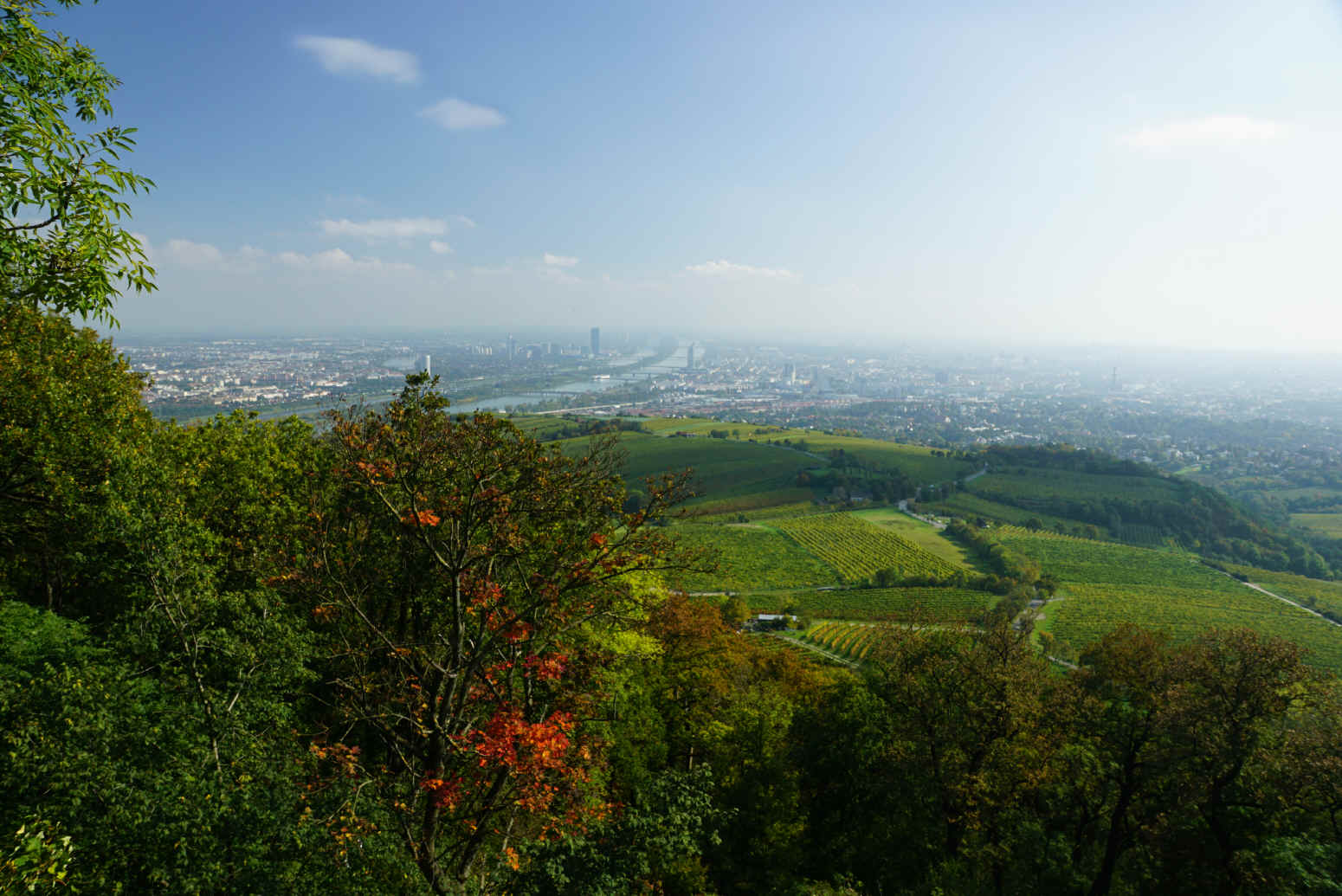
A Trip around the Ring Street
The Ringstraße (or Ringstrasse -- that thing is pronounced like an "s"), or Ring Street, has the most amazing collection of grand public buildings in the world. For a thousand years, old Vienna had had a massive wall around the city, as any city or town had to have in those medieval and Dark Age days. But after the invention of gunpowder and cannons, great city walls eventually became pretty useless, since one big blast could blow a huge hole open in seconds. The walls were expensive to maintain, too, and kept the city from expanding. By the 1800's most city walls throughout Europe had been torn down, somewhat to our regret now, as they were terribly picturesque, but to the people of the time, they were just huge primitive things that were in the way of modernization. Vienna had started expanding far beyond the walled area, so down they came, and all that stone got carted away, legally or not, by happy citizens to build their new houses with.
So what to do with all those hundreds of acres of prime real estate that was suddenly freed up all around the city center? And it was not just the land the walls were sitting on that was now empty -- beyond the walls, it had always been forbidden to build anything for hundreds of yards; after all, if you were being besieged, you wanted to clearly see your enemy out there. So now, suddenly, one of the richest cities in the world had found what any city would dearly love to get, a vast empty area in the best part of town to build on. And did they ever.
Let's go on a walk, clockwise, around the Ring Street. It's really just three-fourths of a circle, as the straight part along the Danube isn't considered part of it. The first half mile or so is pretty, with lots of fine old apartment blocks and hotels, and with the beautiful City Park on one side containing statues and memorials to many of the great composers. If you take a walk through the park, soon you come upon the magnificent Karlskirche (St. Charles Church), a Baroque masterpiece with a green copper dome and giant twisting columns in front.
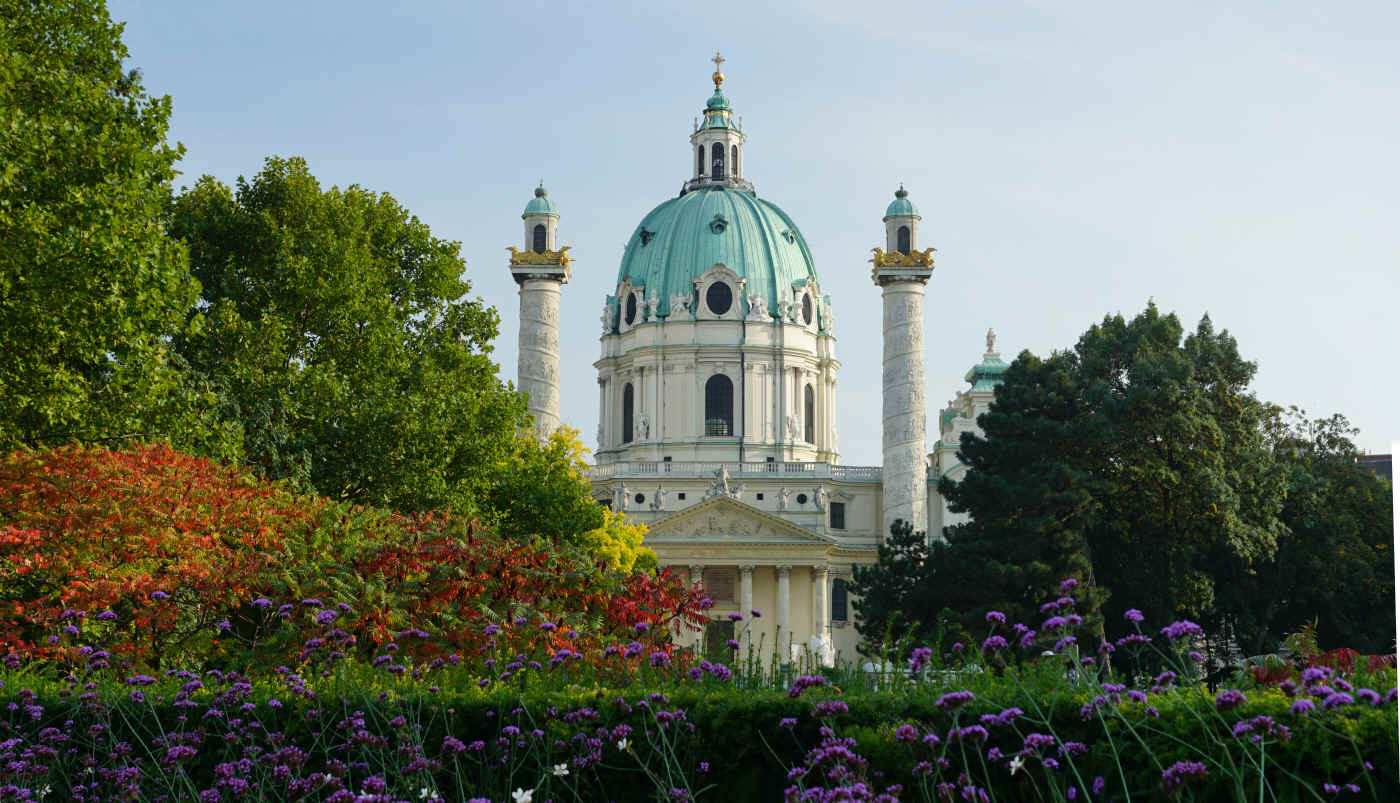
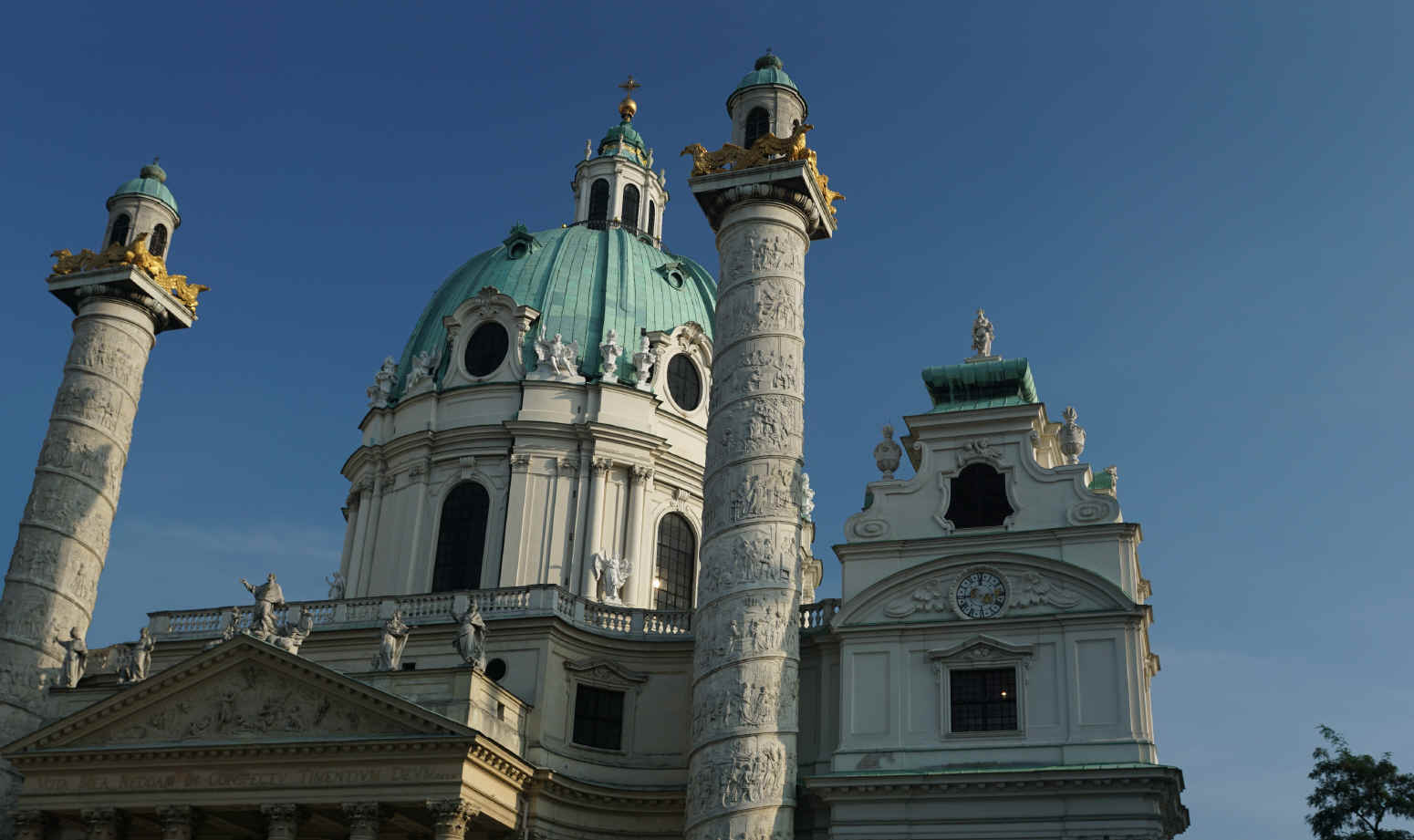
Back up to the Ring Street, you find yourself in front of the impressive Staatsoper, and thus begins the string of grand public buildings that the street is famous for. The Staatsoper, or State Opera House, is one of the most important opera houses in the world, along with La Scala in Milano, Covent Garden in London, and the Metropolitan in New York. Though impressive enough outside, it is not as elaborate as some opera houses, especially that of Paris; but inside it is the most richly decorated of all. It got horribly bombed in WW2, but of all the public buildings in Vienna, it was the first to get built back -- the Viennese had to have their opera! In fact, they have three opera houses -- the Volksoper performs with local, less-known singers at cheaper prices, and the venerable Theater an der Wien performs operettas and comic operas.
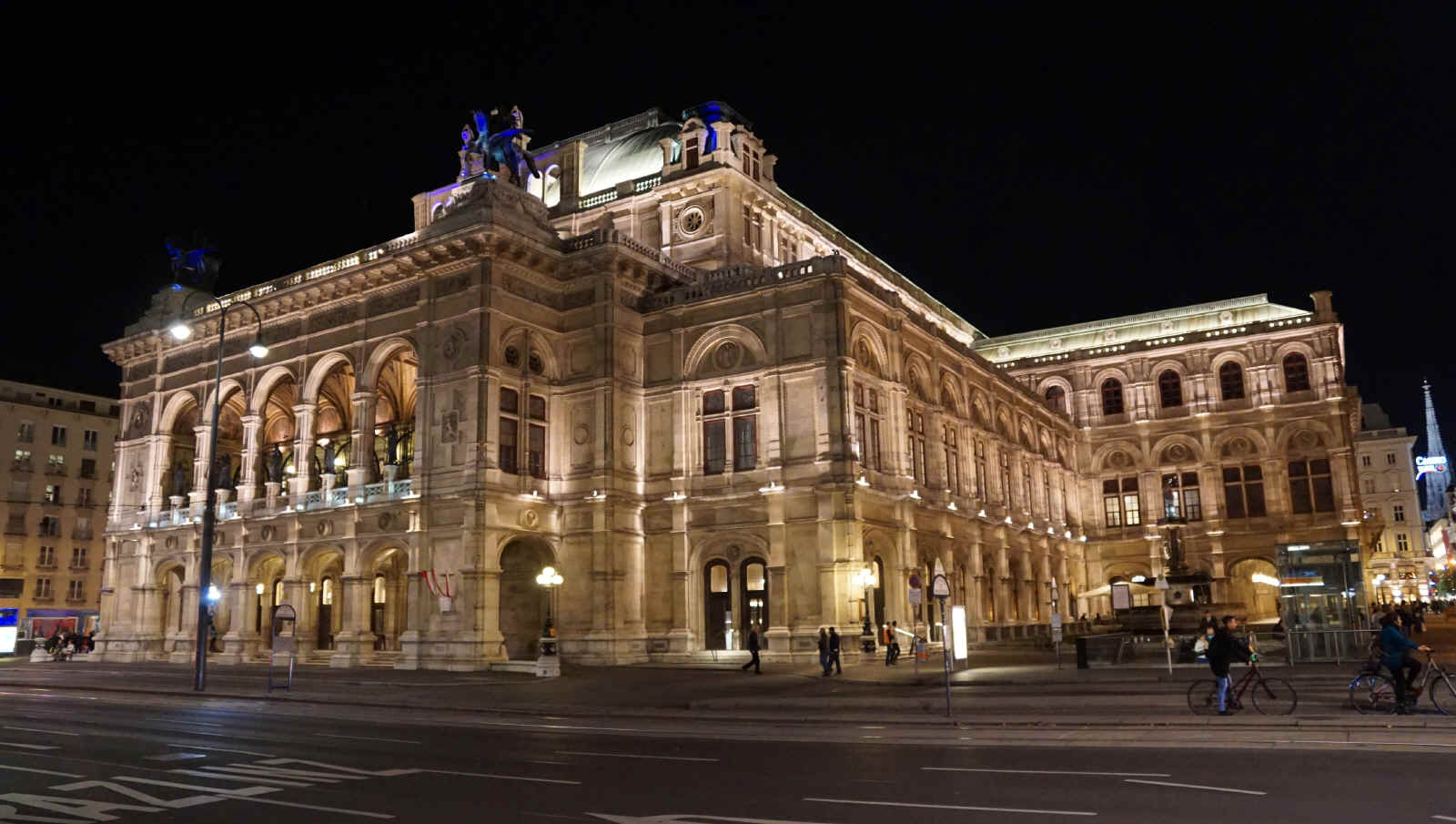
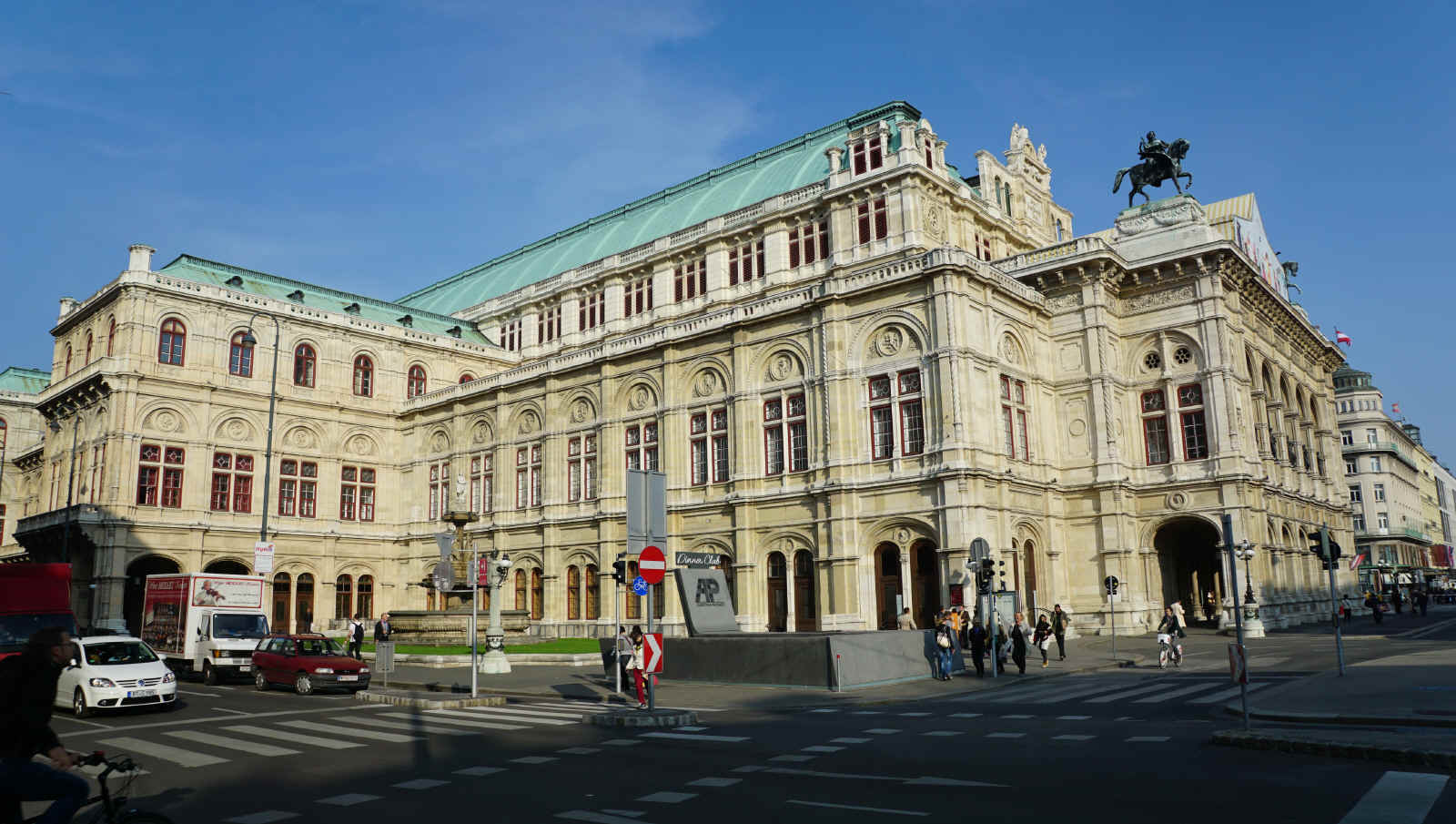
Just a block after the Opera stand the huge two matching museums, the Kunsthistorichesmuseum and the Naturhistorichesmuseum. (German loves to run words together -- those mean the Art History Museum and the Natural History Museum.) They are practically identical, built in a monumental style, facing each other across a pretty plaza where a grand statue of the Empress Maria Theresa sits, the only woman who was the ruler of Austria (and the mother of Marie Antoinette, who became queen of France before she got her head chopped off).
The
Kunsthistorischesmuseum:
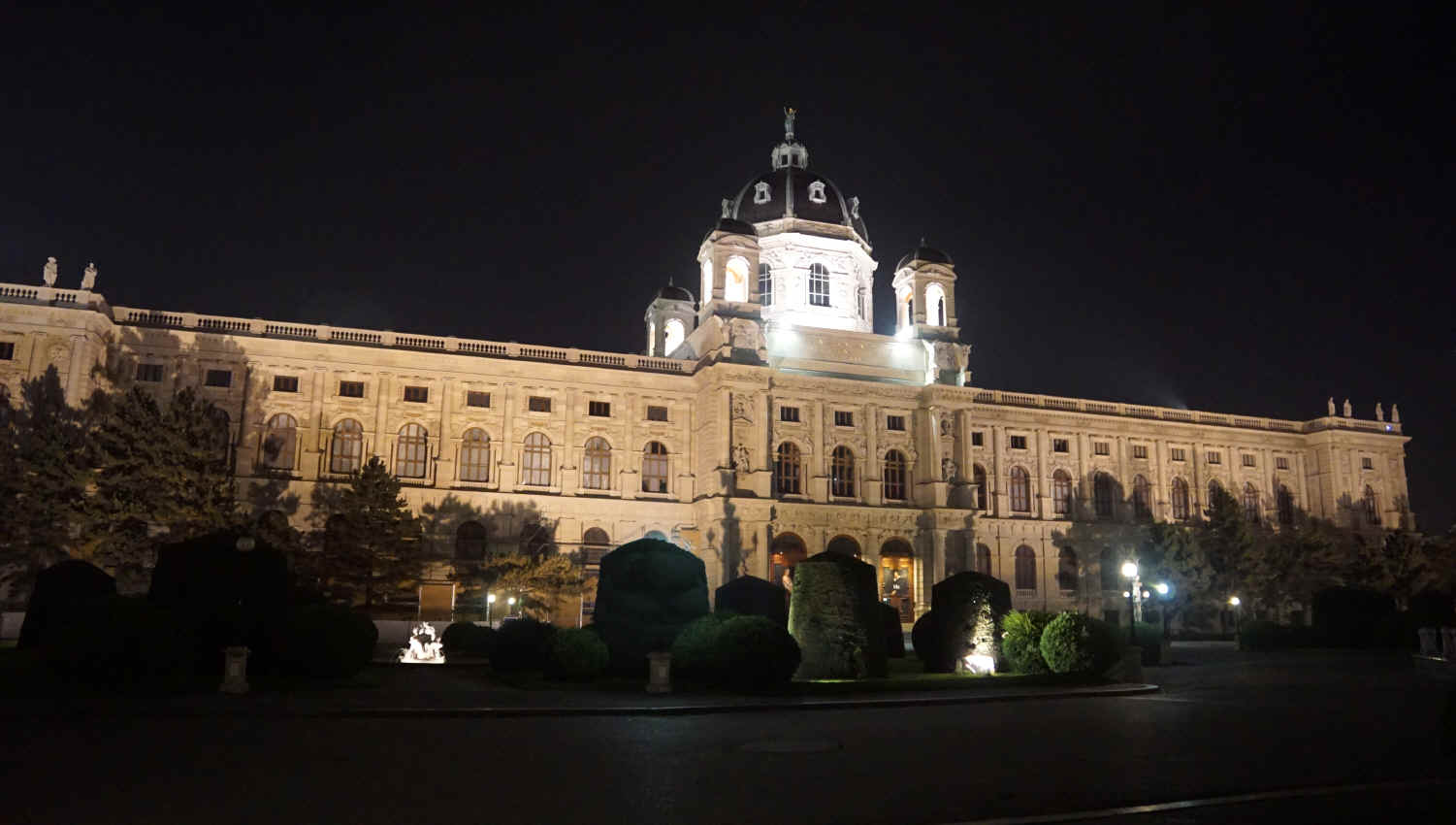
Inside
the Kunsthistorischesmuseum:
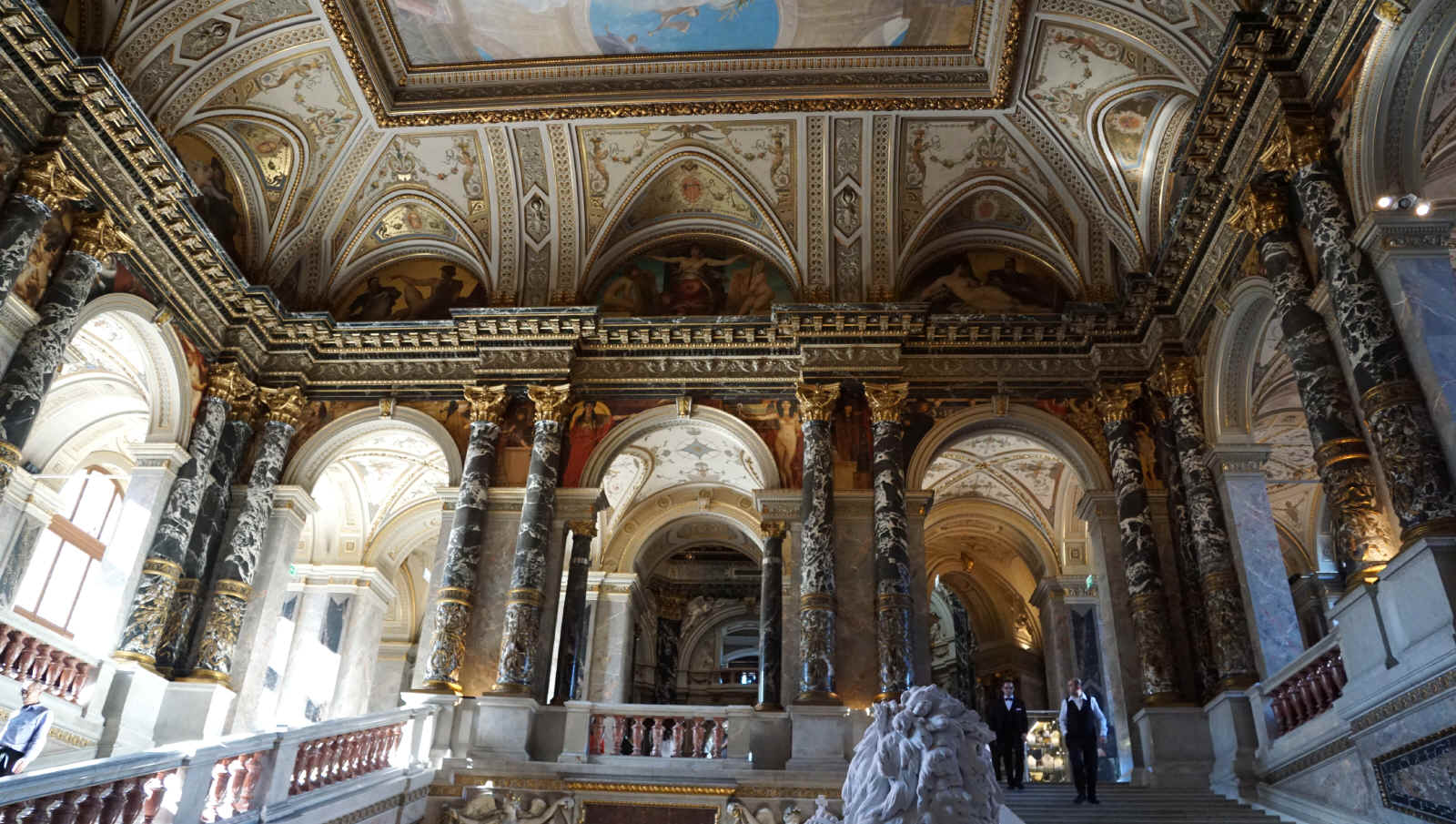
The Empress Maria Theresa:
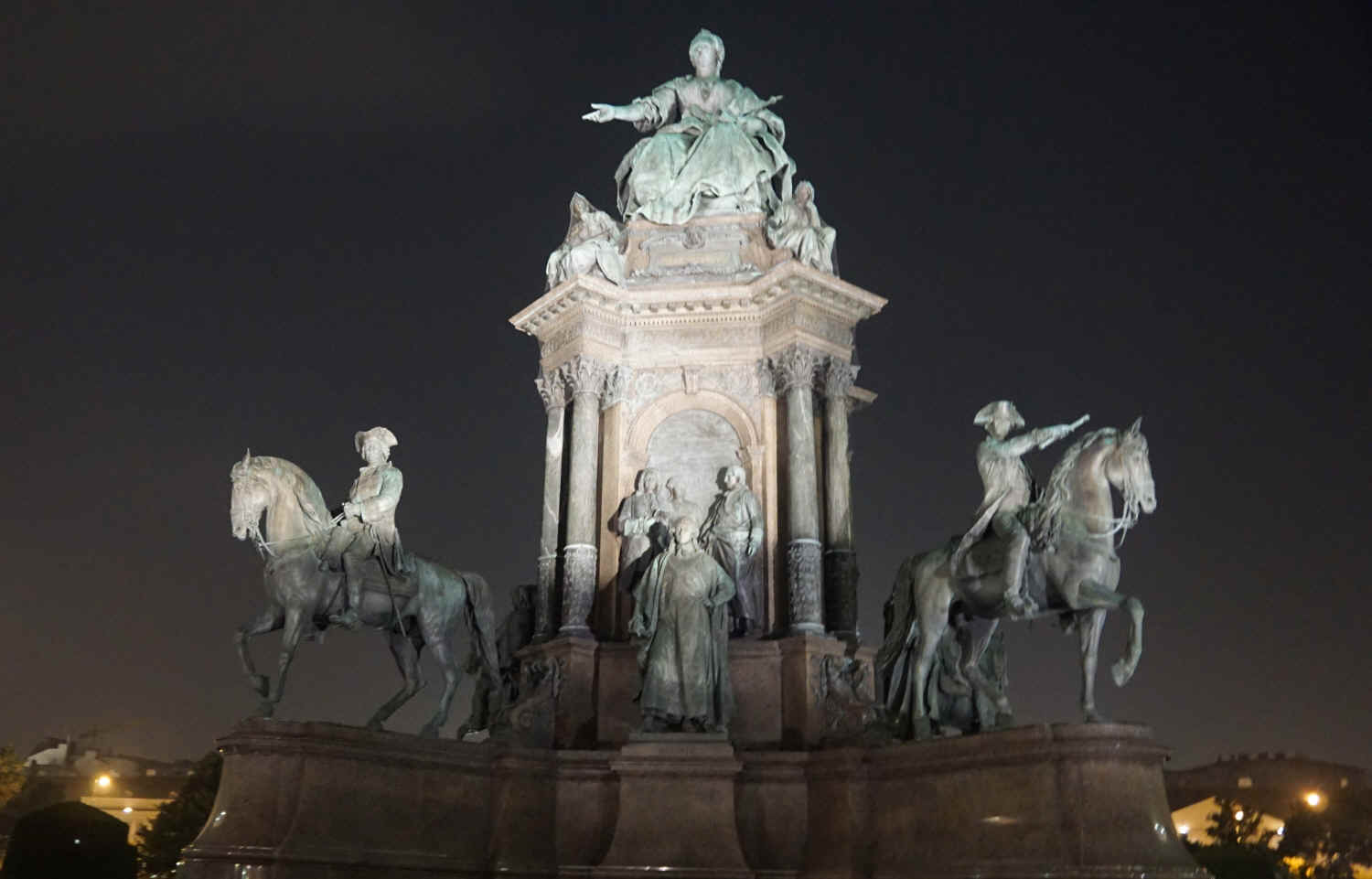
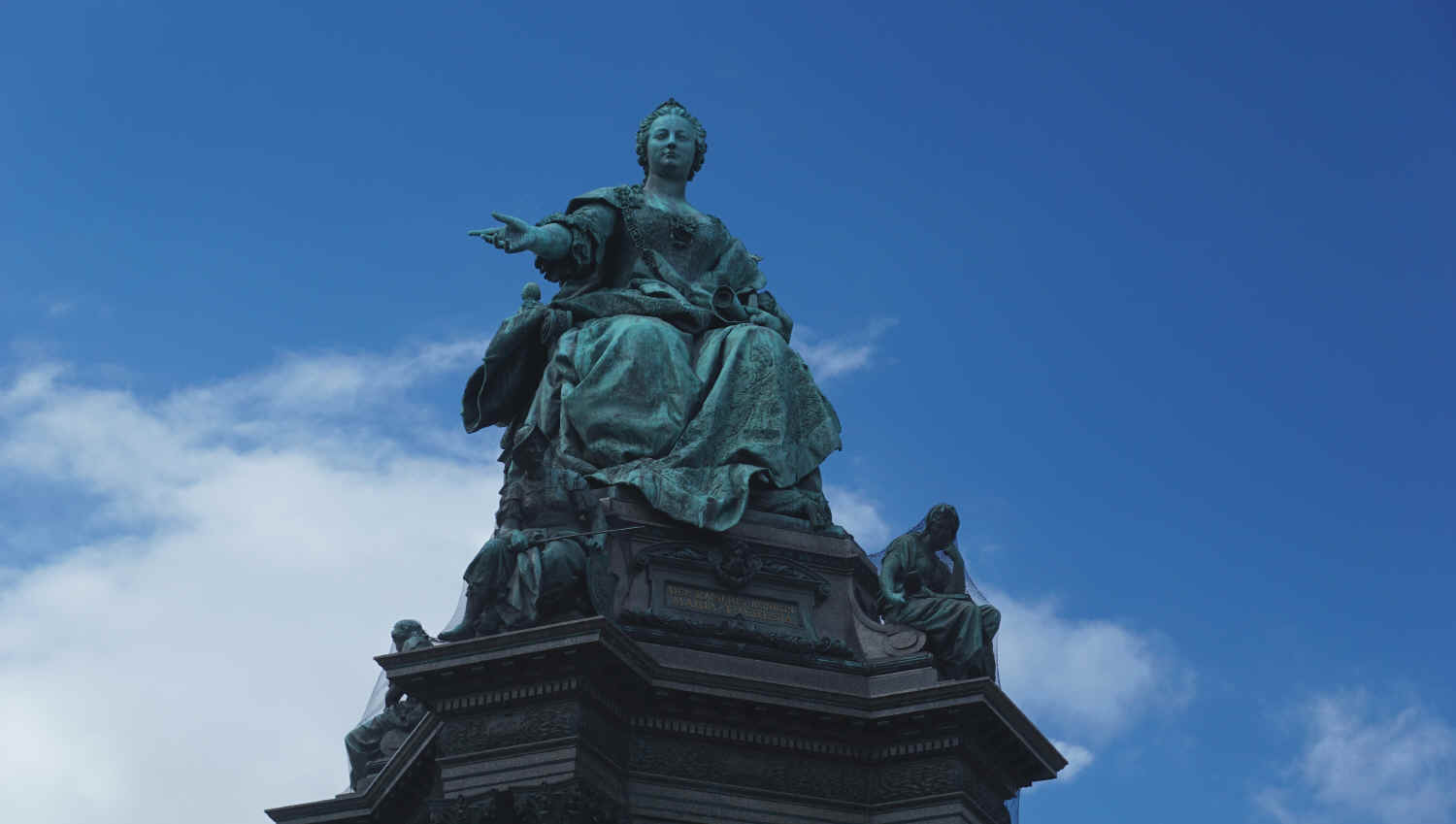
The
Naturhistorischesmuseum, or Natural History Museum, sits directly across from
the Art History Museum, and is identical to it on the outside.
If you
go to the end of the plaza between the two museums, you will see the
Justizpalast (Palace of Justice) -- the equal to our Supreme Court. It is
not directly on the Ringstreet, but it faces it from a distance.
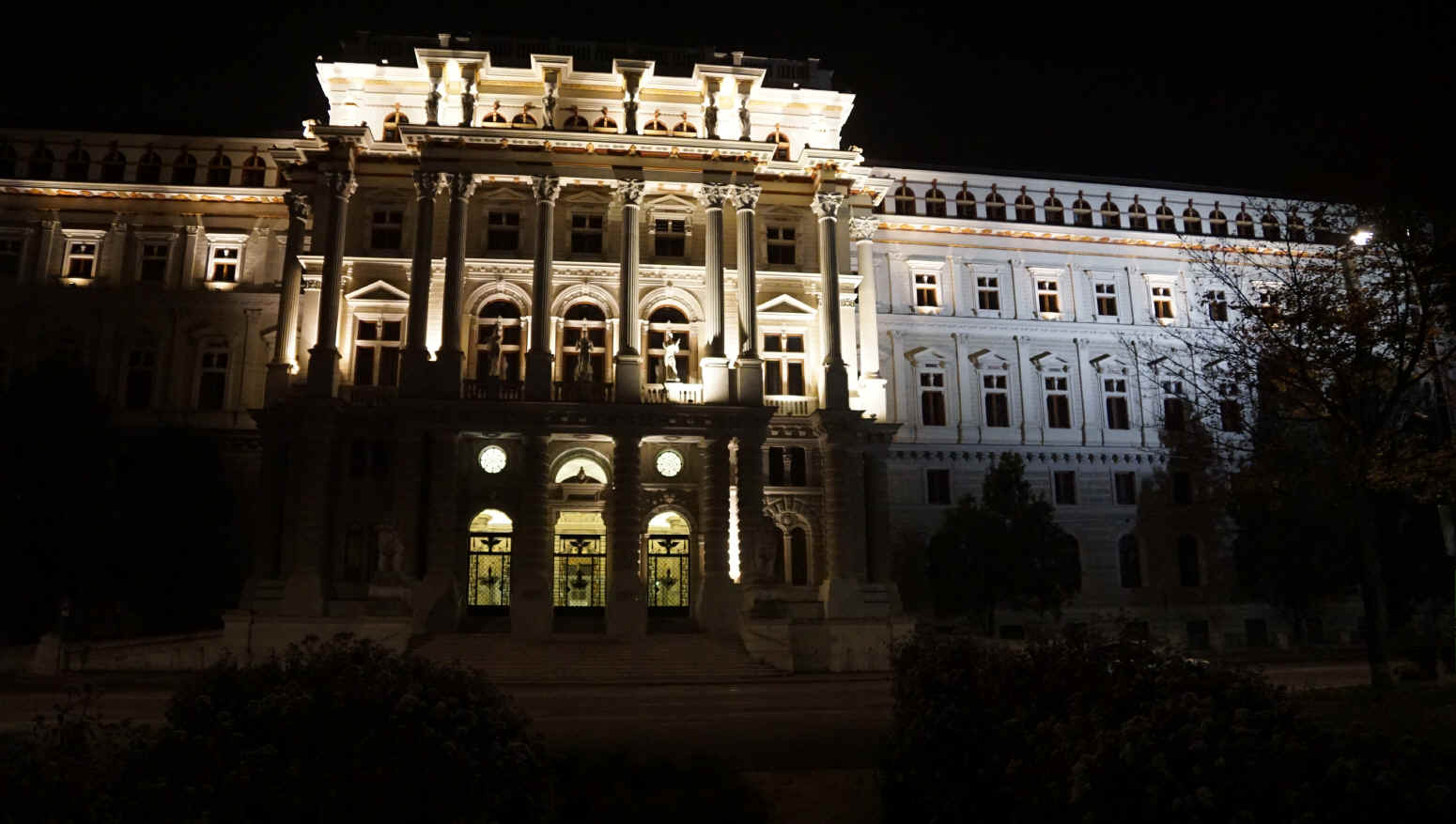
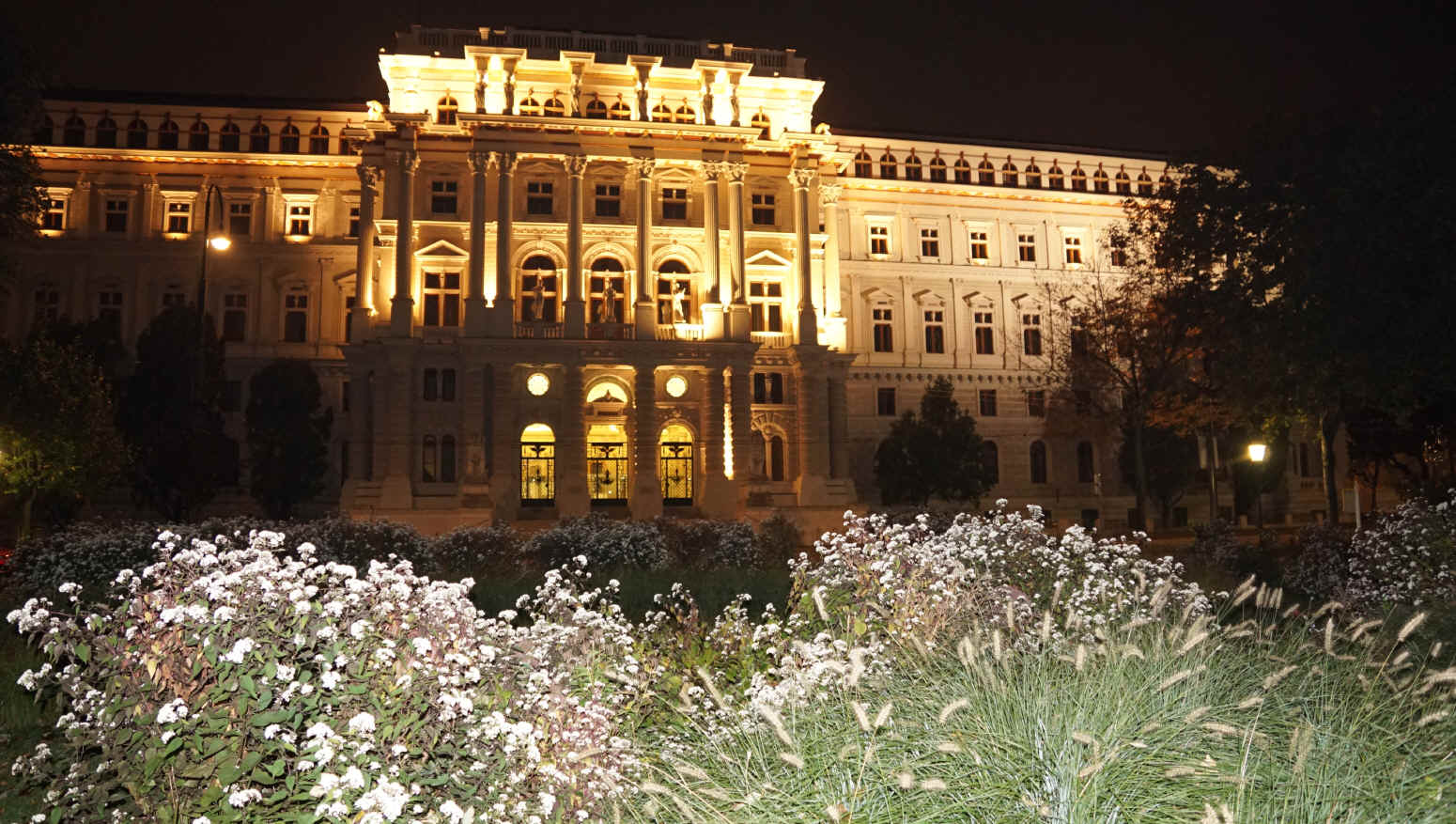
Just across the Ring Street from the two great museums is the enormous Hofburg, which was the Imperial Palace of the emperors and the seat of government for many centuries. Nowadays it houses the National Library, the Museum of Armor, the Museum of Musical Instruments, and the famous Spanish Riding School, where the beautiful white Lippizaner horses train and put on shows nearly a hundred times a year -- yes, right inside the palace, in a huge ballroom with a dirt floor and crystal chandeliers.

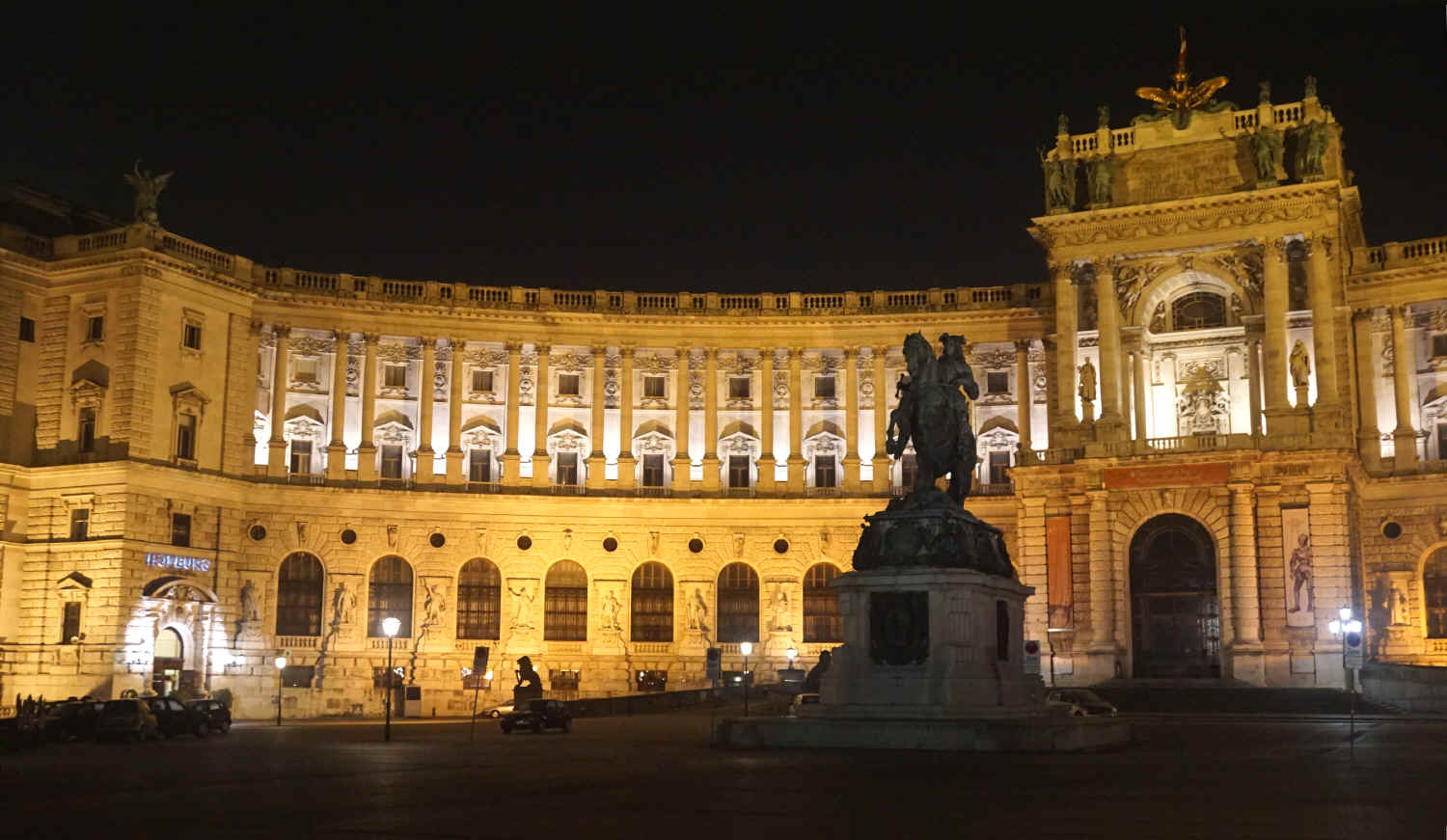
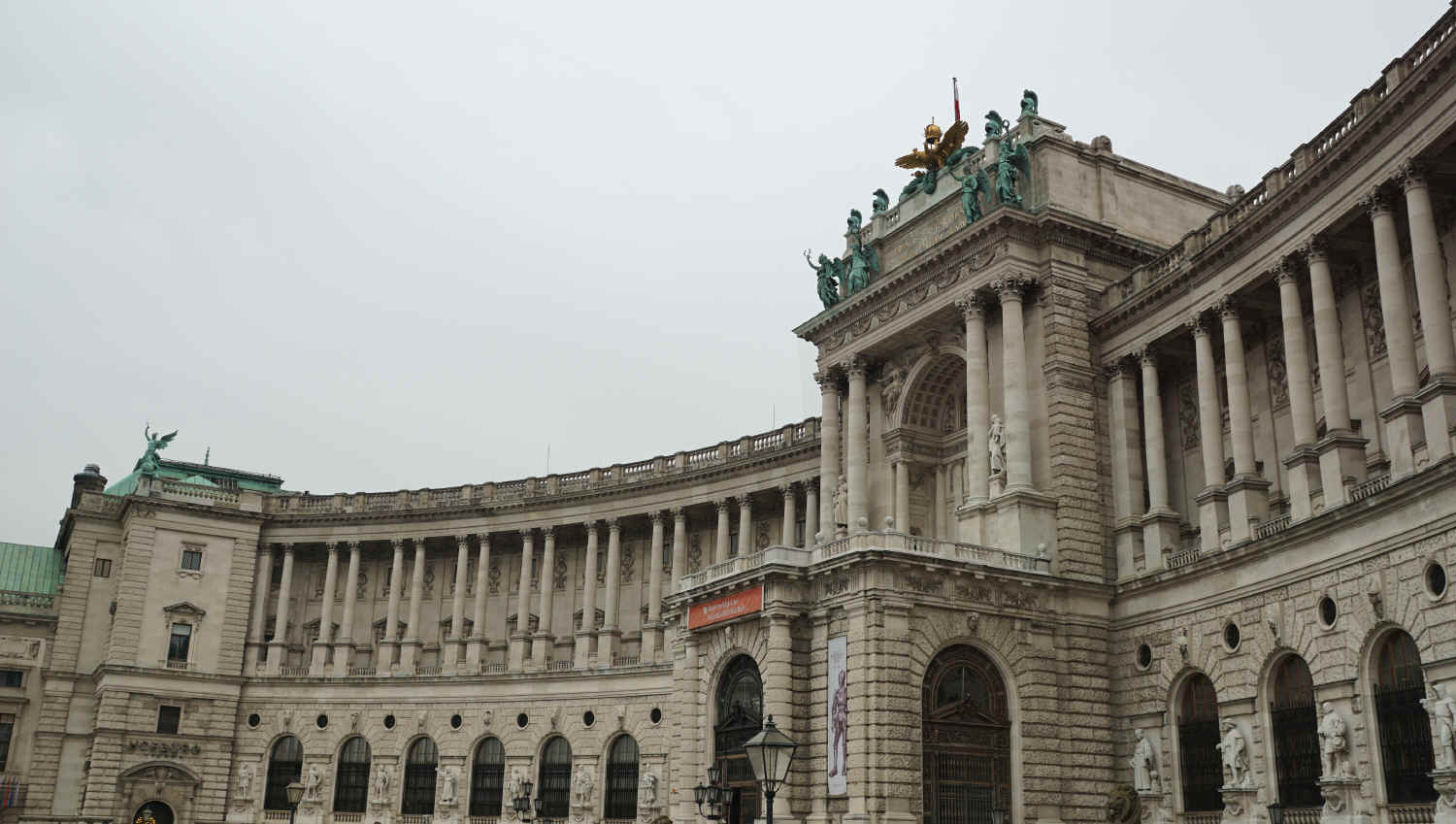
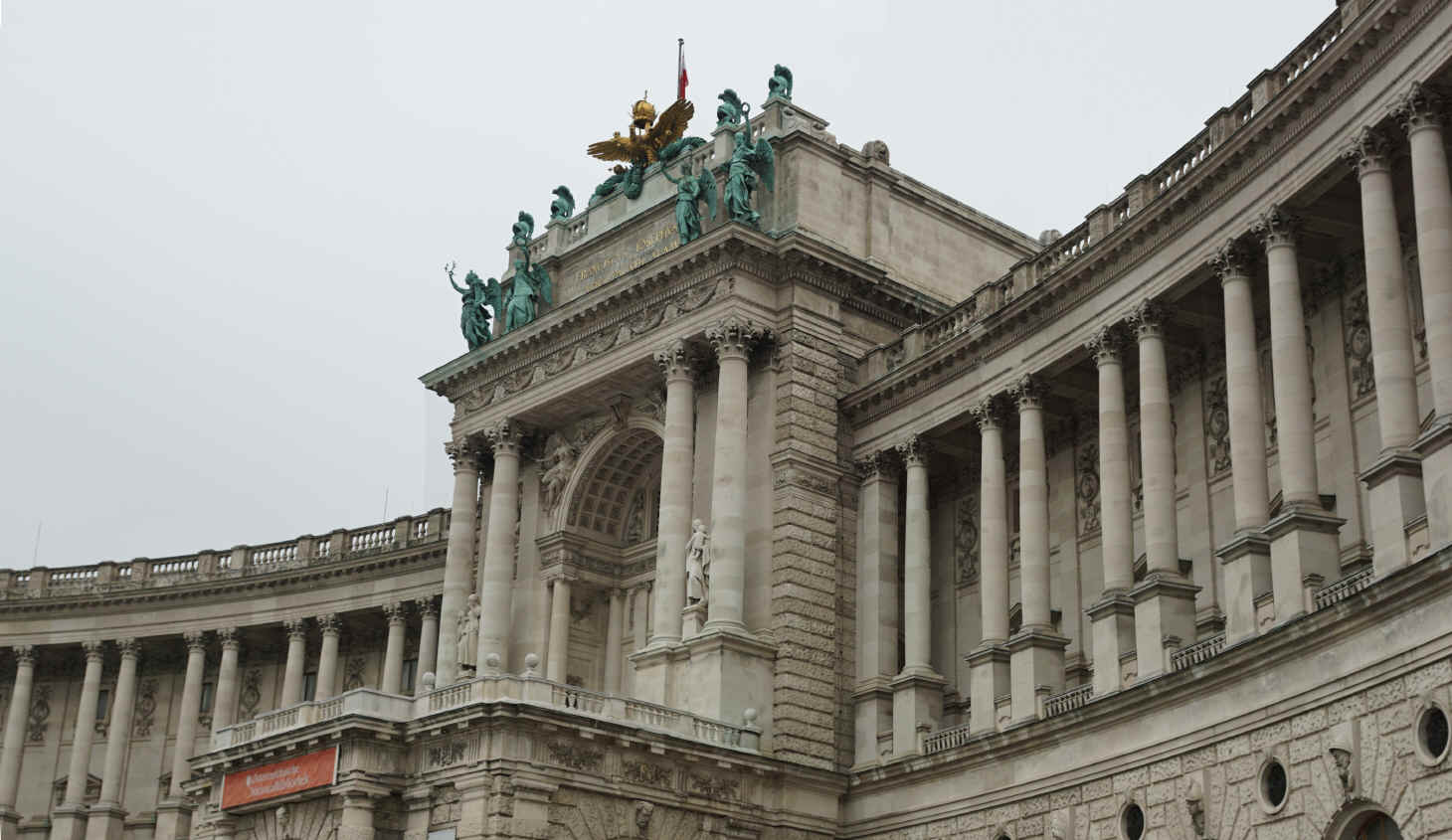
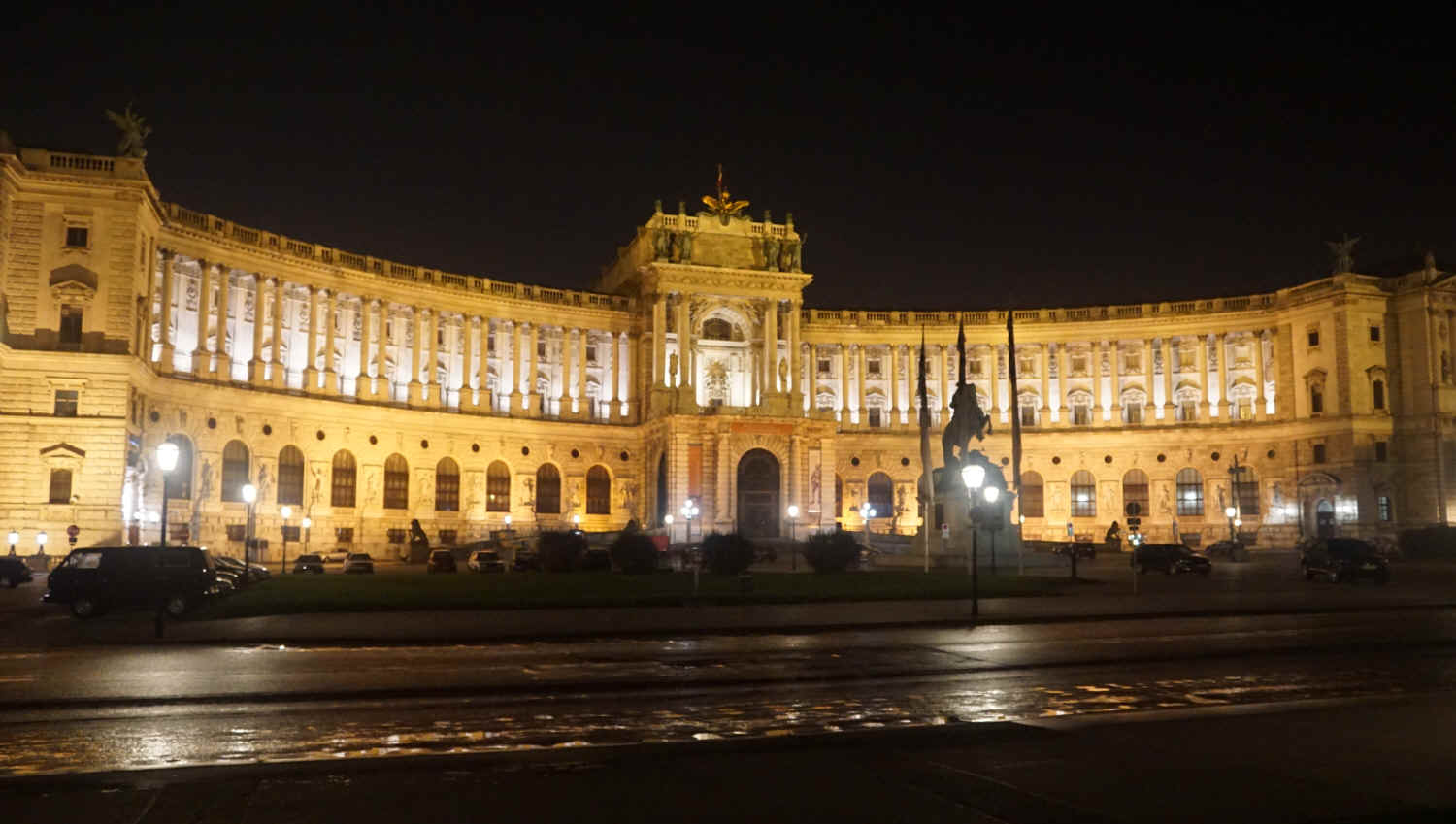
This is
the Joseph Plaza, the main entrance from the back side of the Hofburg Palace.
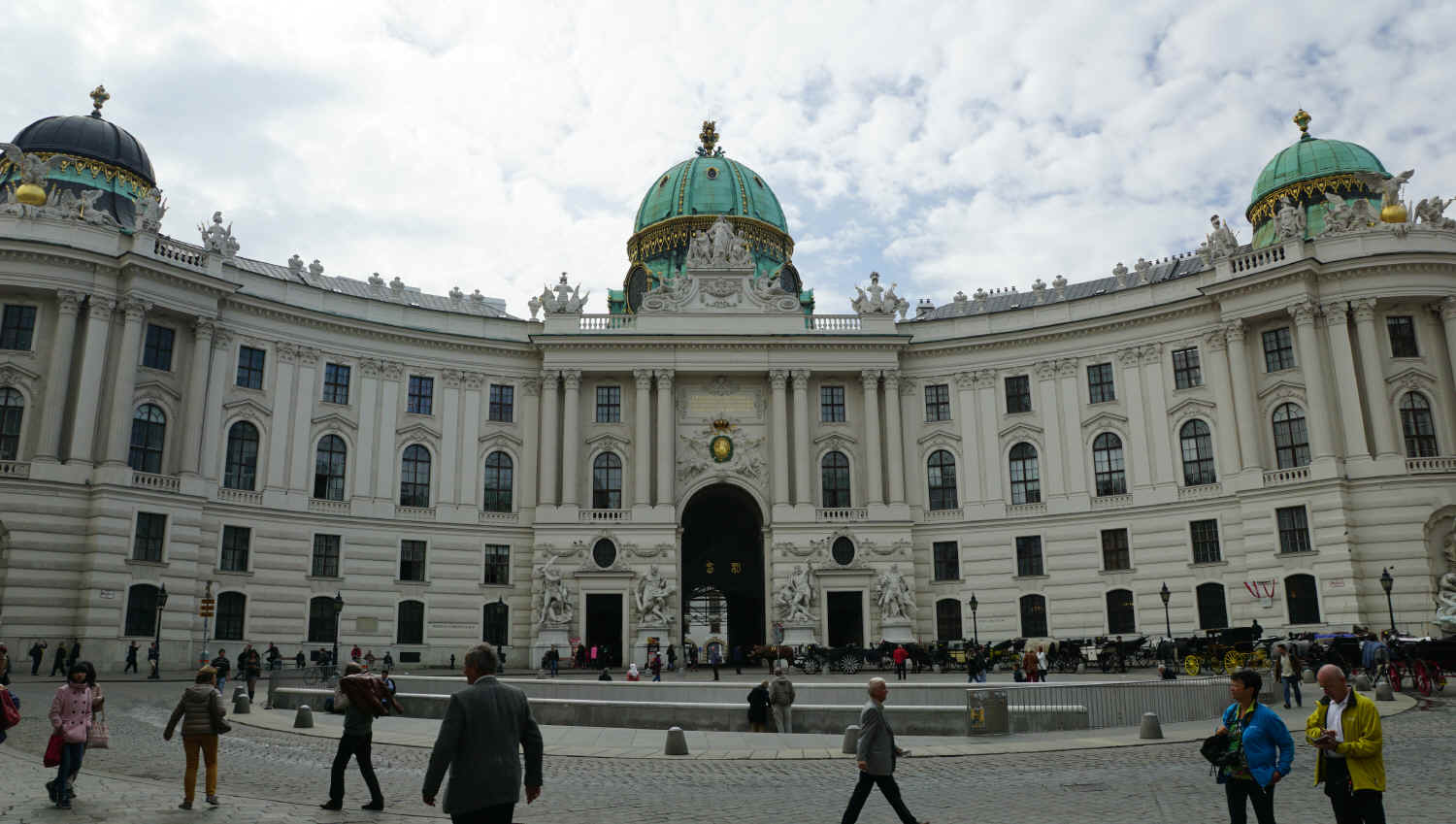

In front
of the Hofburg Palace is this statue of the Archduke Charles of Austria, who
fought Napoleon more times than any other commander did.
The domes behind it are the Art History Museum and the Natural History
Museum.

In front
of the Hofburg is a large formal garden, and
beyond that, on the other side of the Ring Street, stands the Parliament
Building, which is the capitol building of the whole country of Austria.
It was designed in a monumental Greek temple style, one of the largest buildings
in the world to be inspired by the ancient Parthenon in Athens. But
whereas the Parthenon is just a tragic ruin now, the Parliament is spectacularly
decorated, as the old Greek temples may well have been 3000 years ago, with gold
and marble statues everywhere. The main statue in front is Pallas Athena,
the goddess of wisdom, law, and justice.
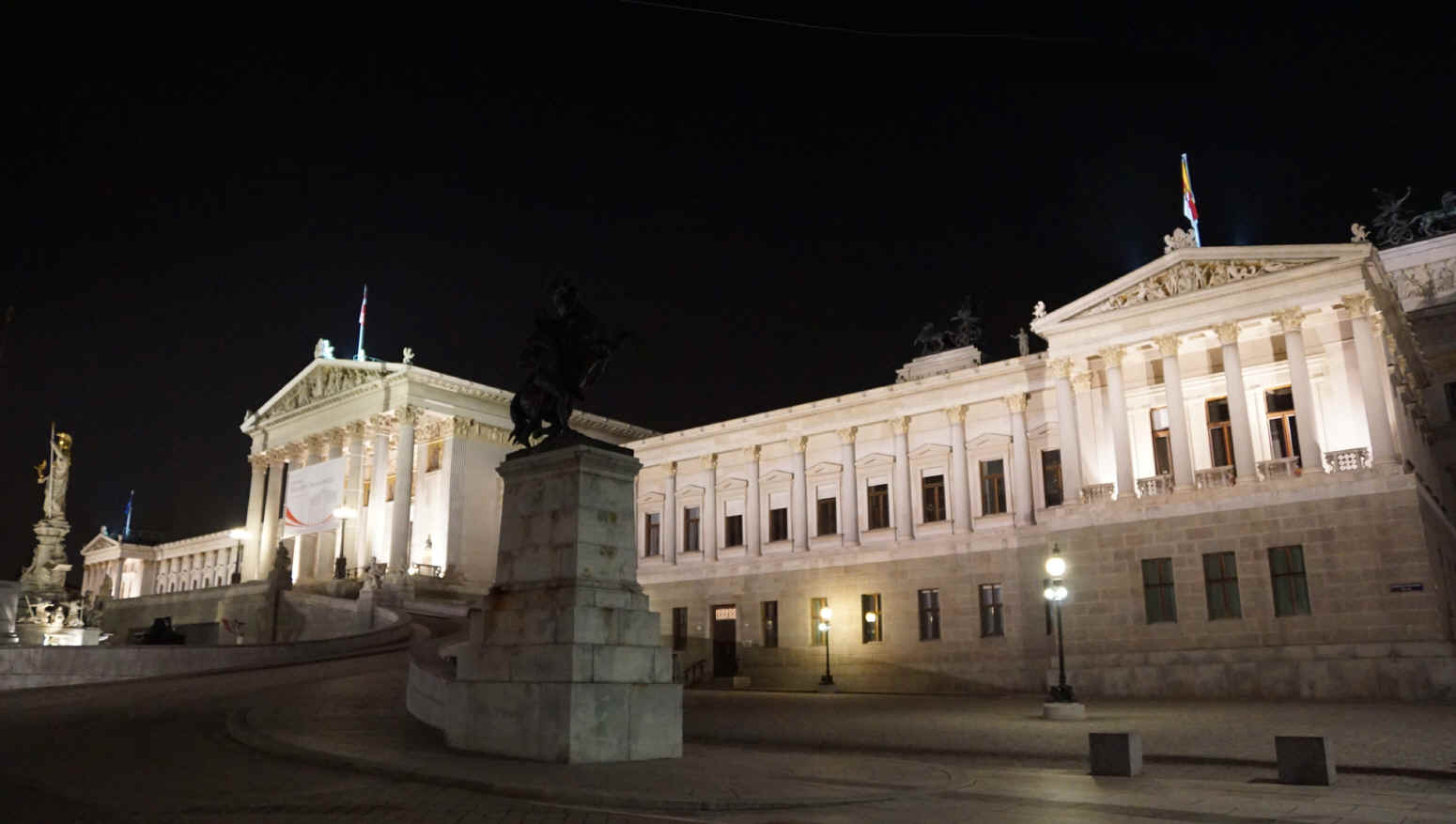
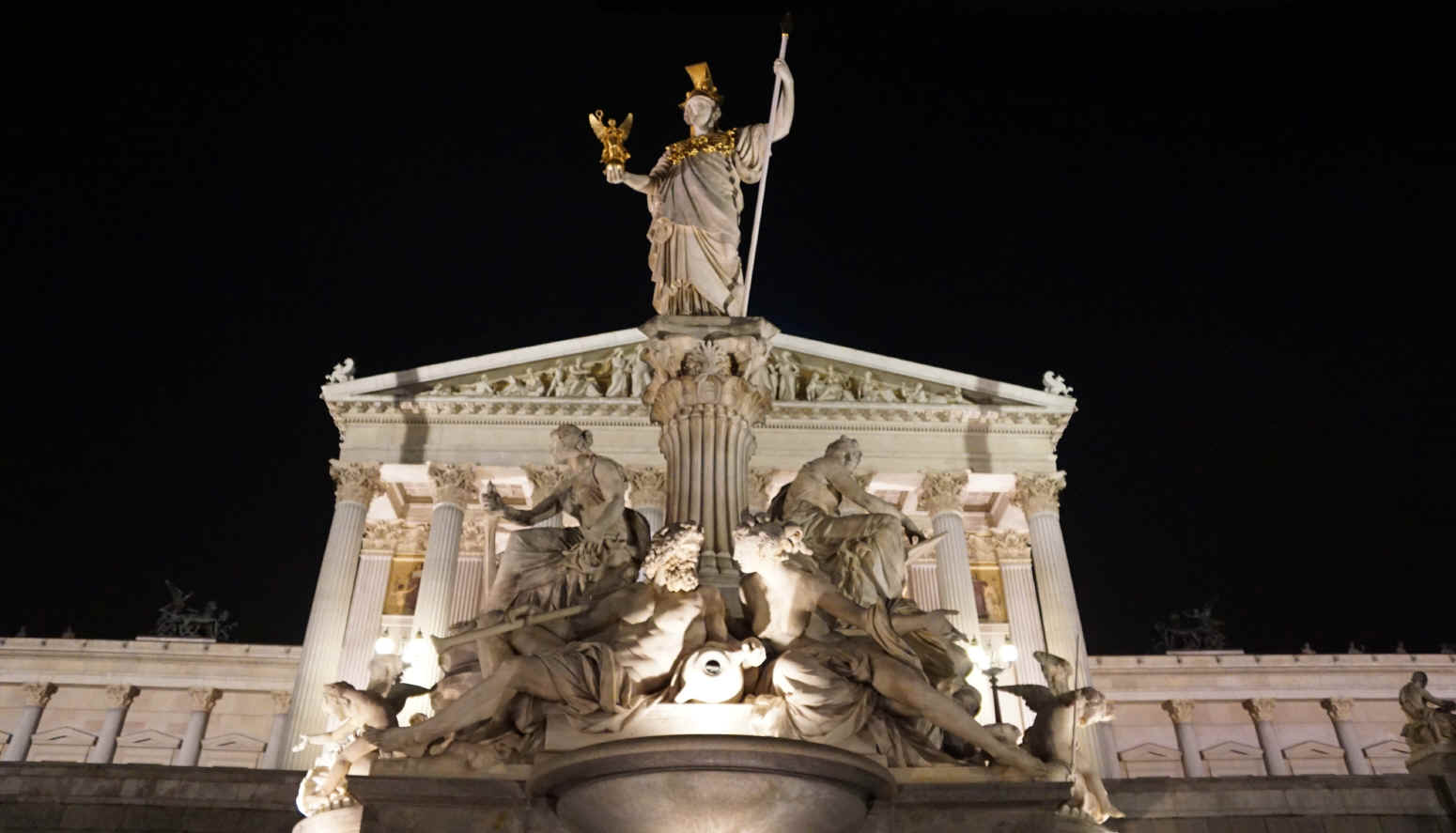
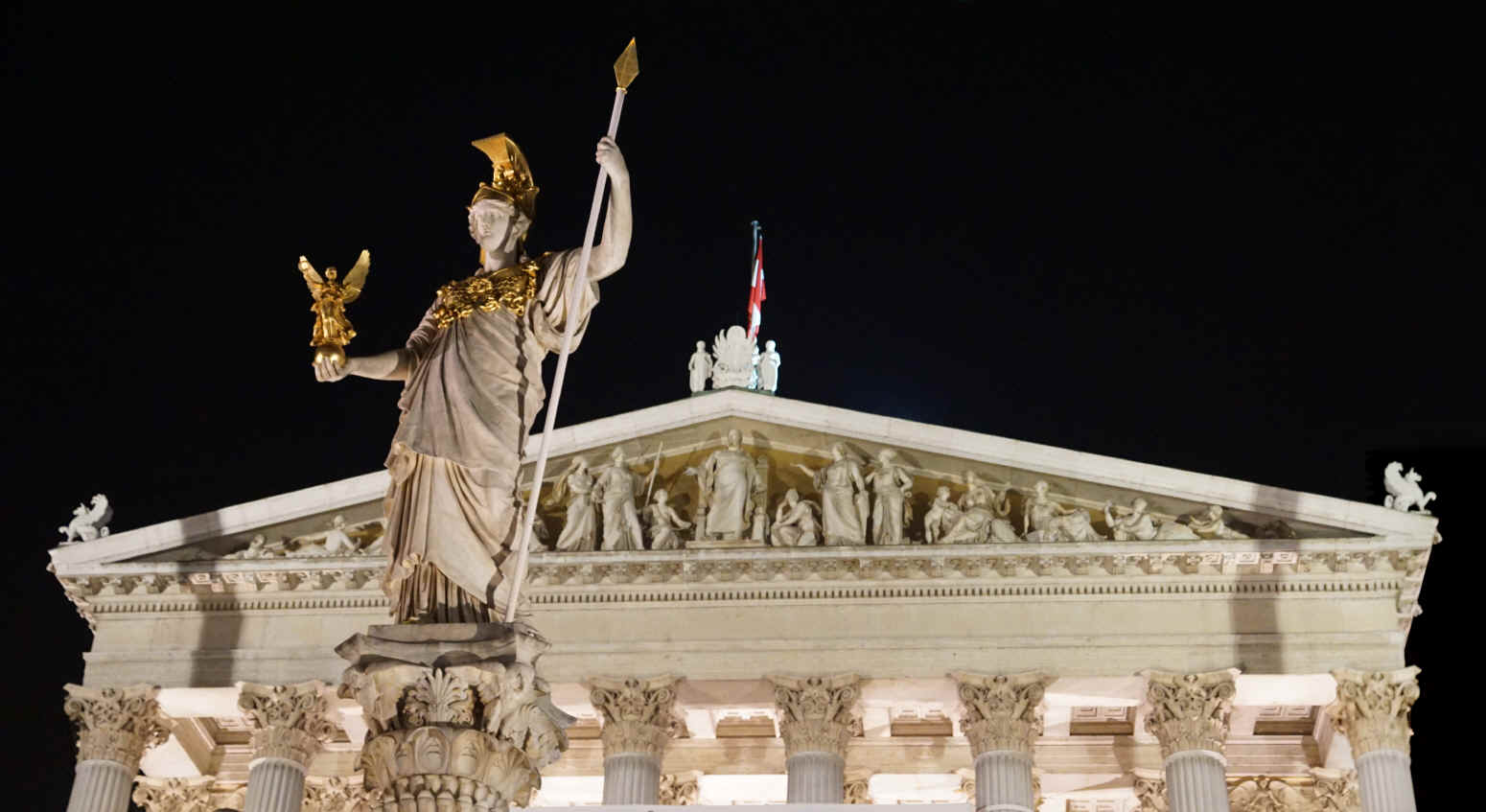
Standing
right next to the Parliament is the most imposing building of them all -- the
Rathaus. That may not sound too impressive, but it is equivalent to City
Hall in English. It seems odd that the city hall is even larger than the
capitol building, with a grand plaza in front of it also; but knowing the Viennese, they quite possibly thought that their city was more
important than all the rest of the country. It was designed in the
intricate, highly vertical style of the Gothic period, where the main lines of
the architecture tend to draw your eyes up and up. But for reasons
inexplicable, there was a big circus tent set up right smack in front of the
Rathaus the whole time I was there! The Roncalli Circus from Italy was in
town -- sure, why not just perch it right in front of the City Hall?
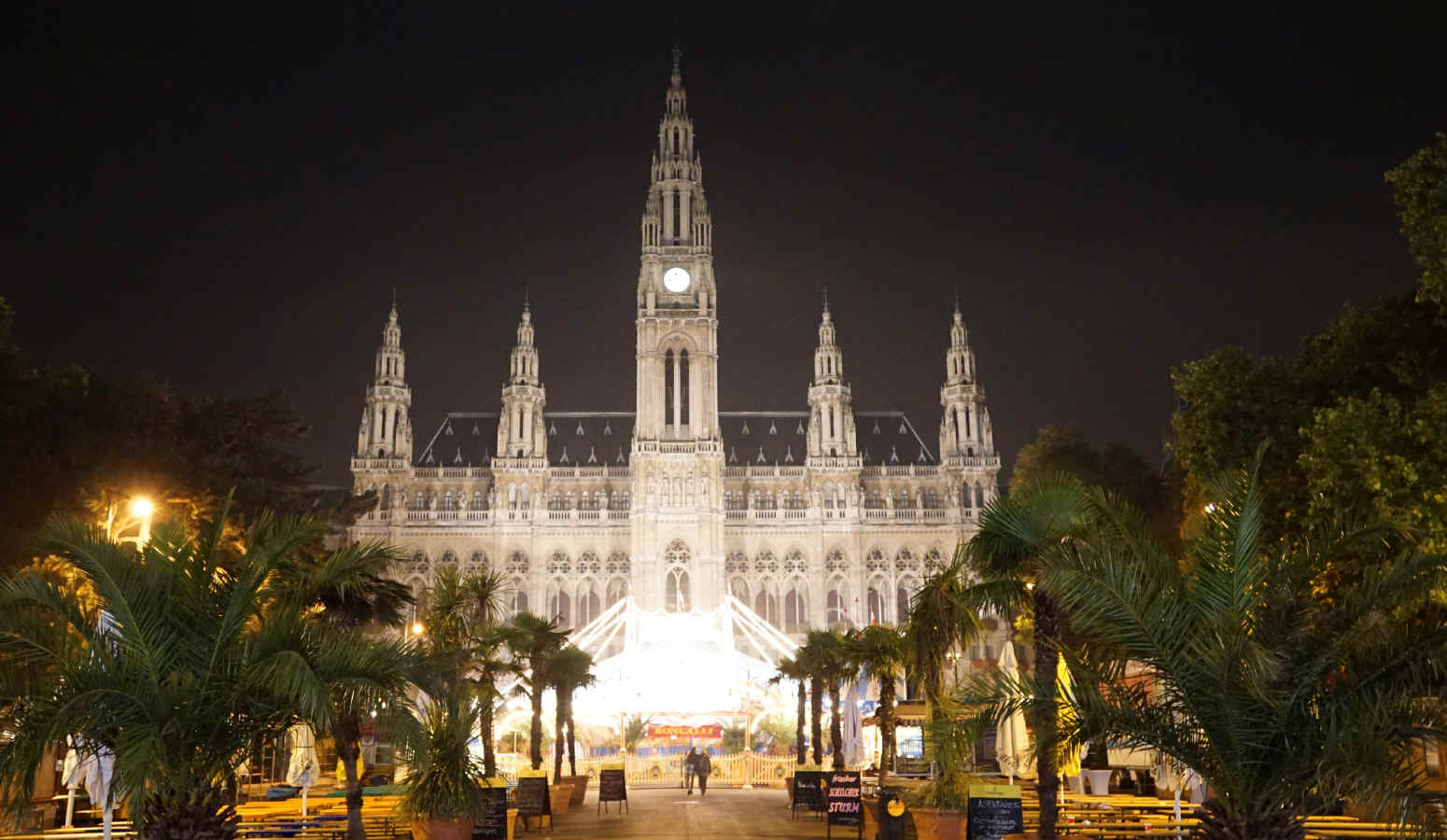
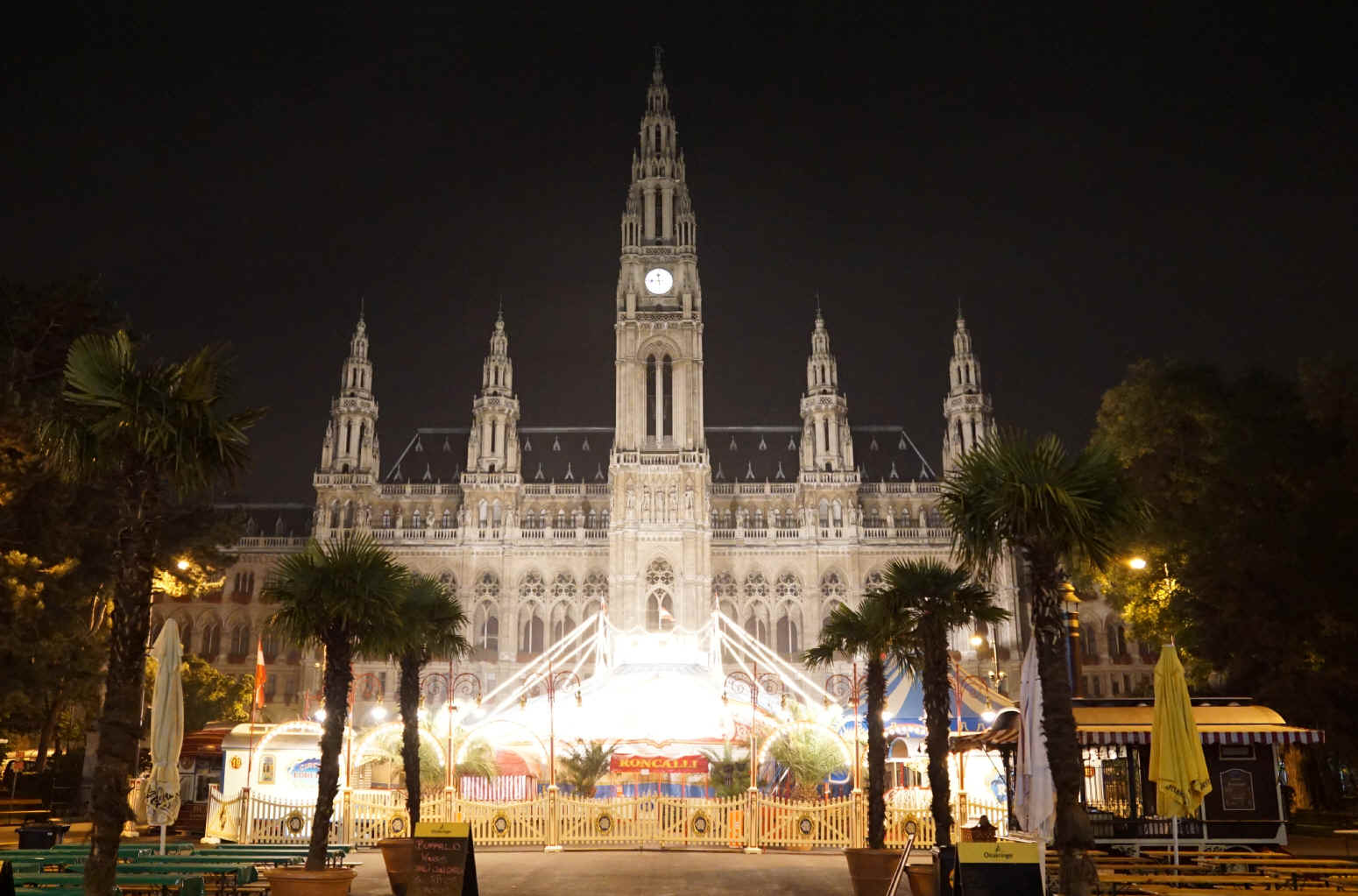
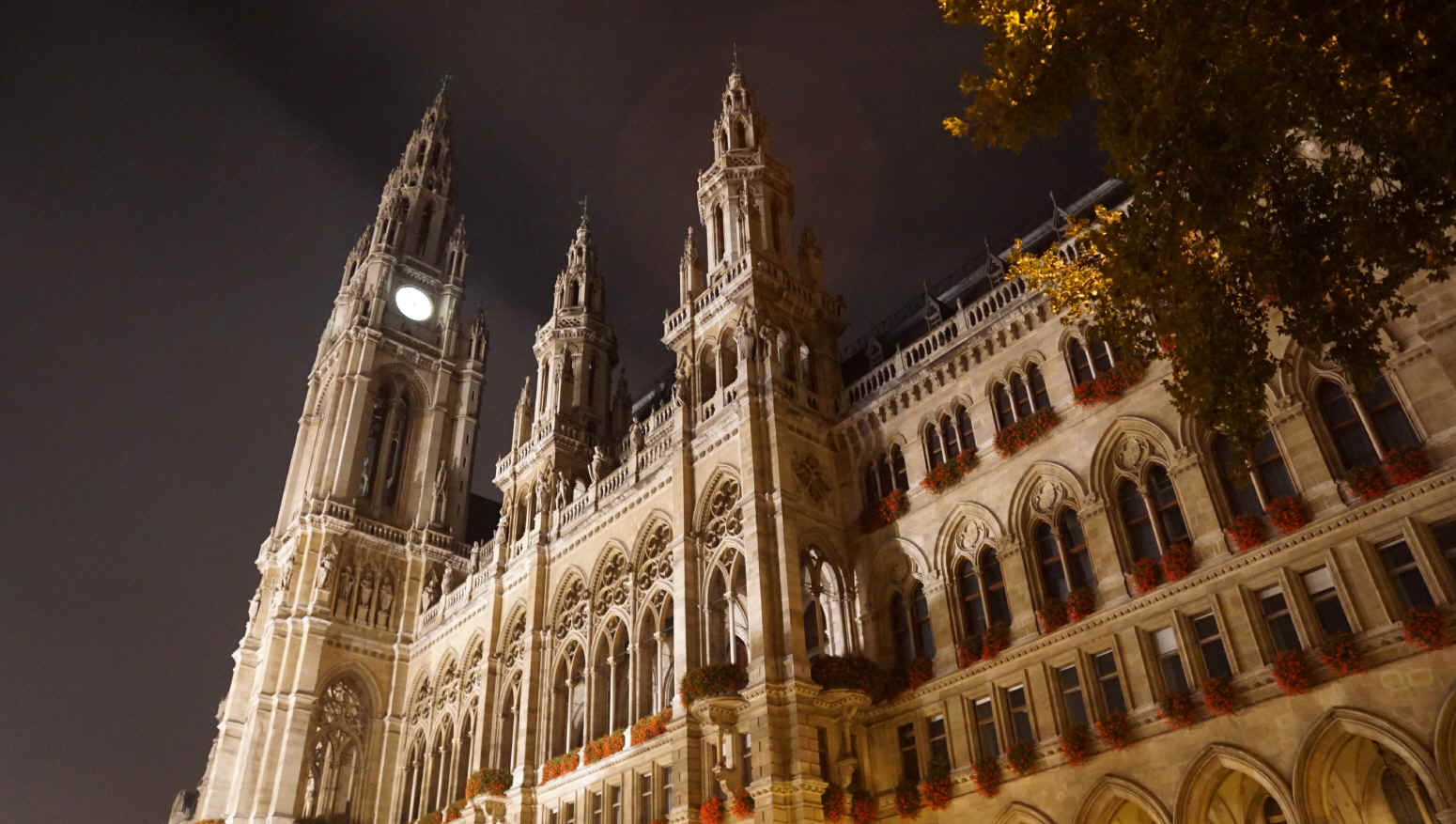
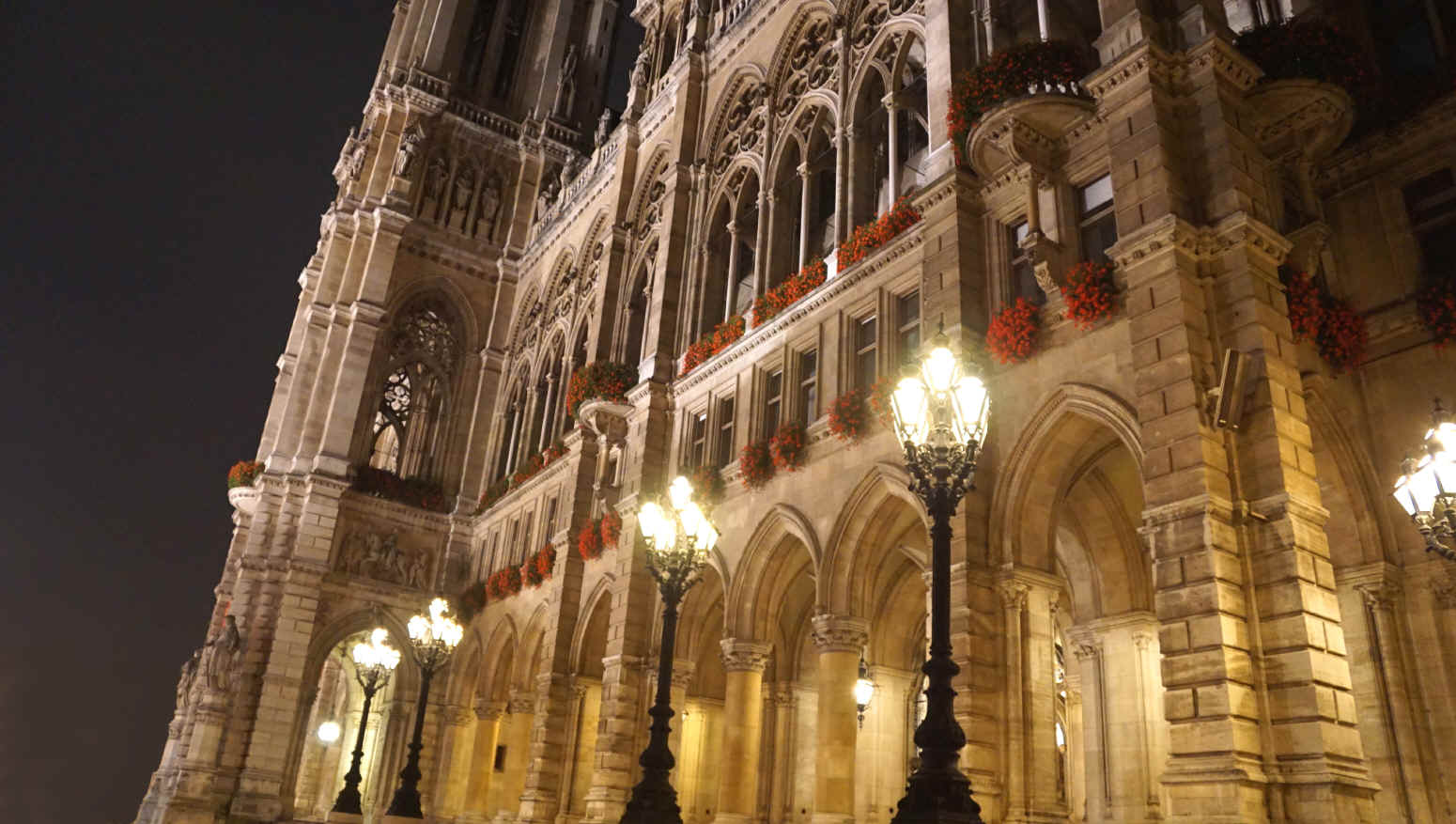
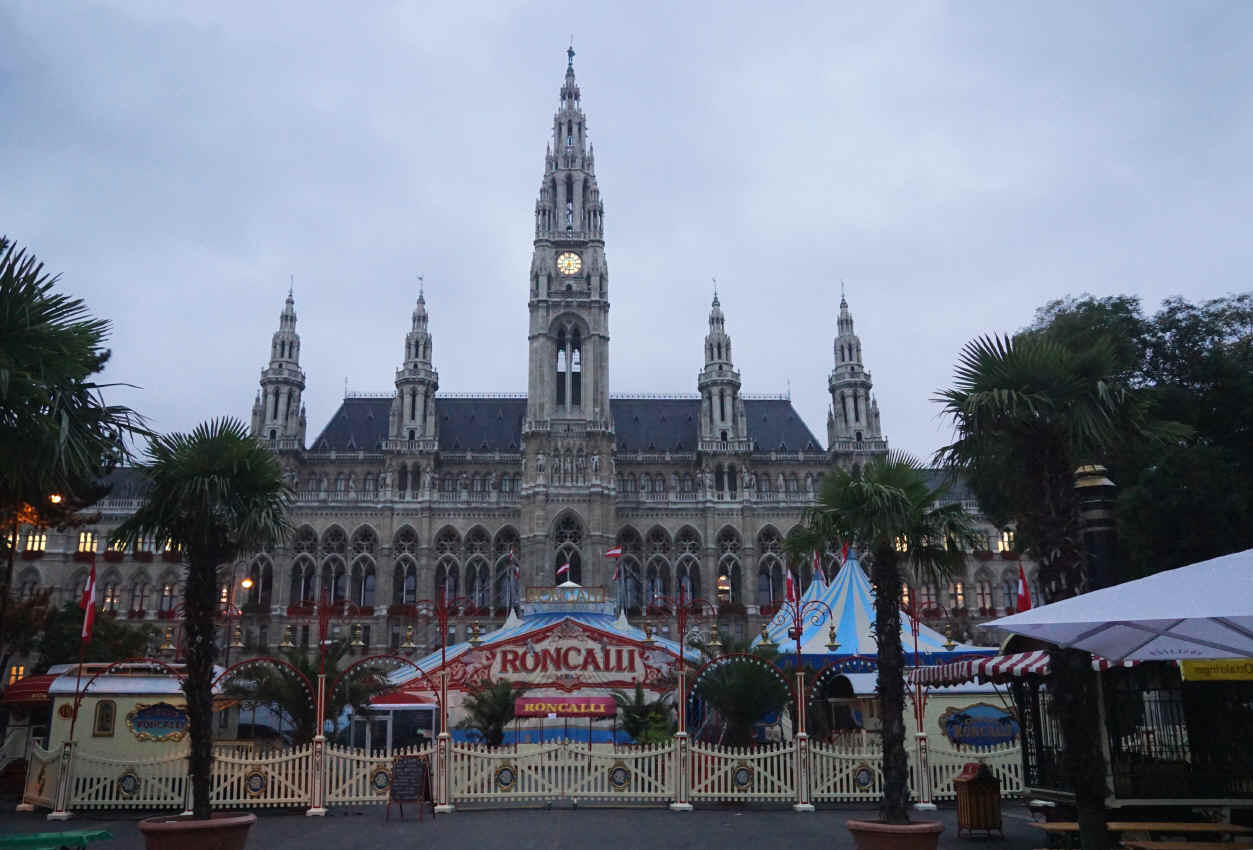
Just
next door to the Rathaus, the next great building is the University of
Vienna. We tend to think of a university as usually being spread out in
many buildings over hundreds of acres, and so it is now, occupying many blocks
behind the main building on the Ringstraße. But at the time the
University was built, when few people went to college, this one building was the
whole thing and all they needed; but it is truly huge. The sober and
restrained Renaissance style was chosen for its architecture, representing the
rebirth of culture and learning, which is what the true Renaissance period in
Italy had been after the long dark medieval centuries.
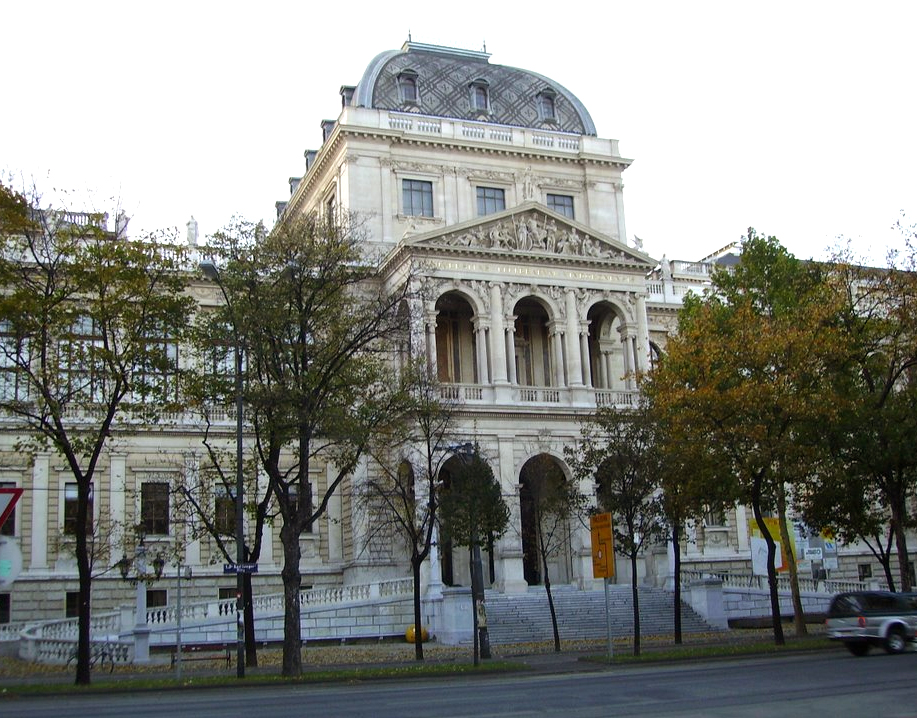
Right
across the Ring Street from the monumental trio of the Parliament, City Hall,
and University, is the beautiful semi-circular Burgtheater, or City
Theater. It is the most important venue in the German-speaking world for
spoken plays and dramas (they were performing Shakespeare's King Lear in
German when I was there). Any German actor dreams of being able to perform
there some day, and those who have played a leading role at the Burgtheater are considered to have reached the ultimate of their art and career.

One of
the prettiest things in Vienna is the Votivkirche, which stands right next to
the University -- but it has been wrapped in scaffolding for years now, as they
do a major cleanup of the front, so I didn't get any decent pictures.
Emperor Franz Joseph had it built in thanks for having escaped an assassination
attempt.
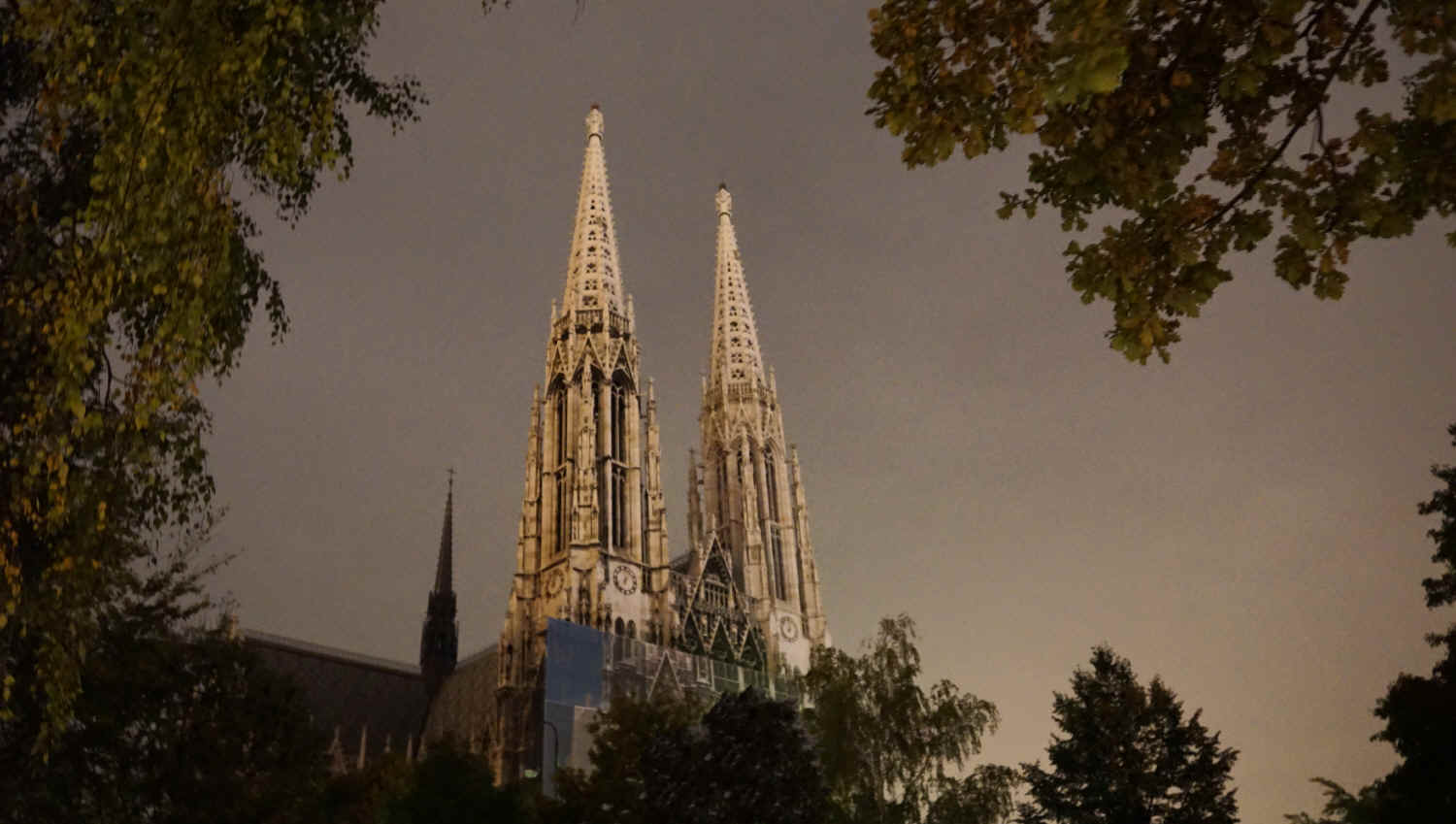
The last
major building on the Ring Street is the Börse, or the Stock Exchange.
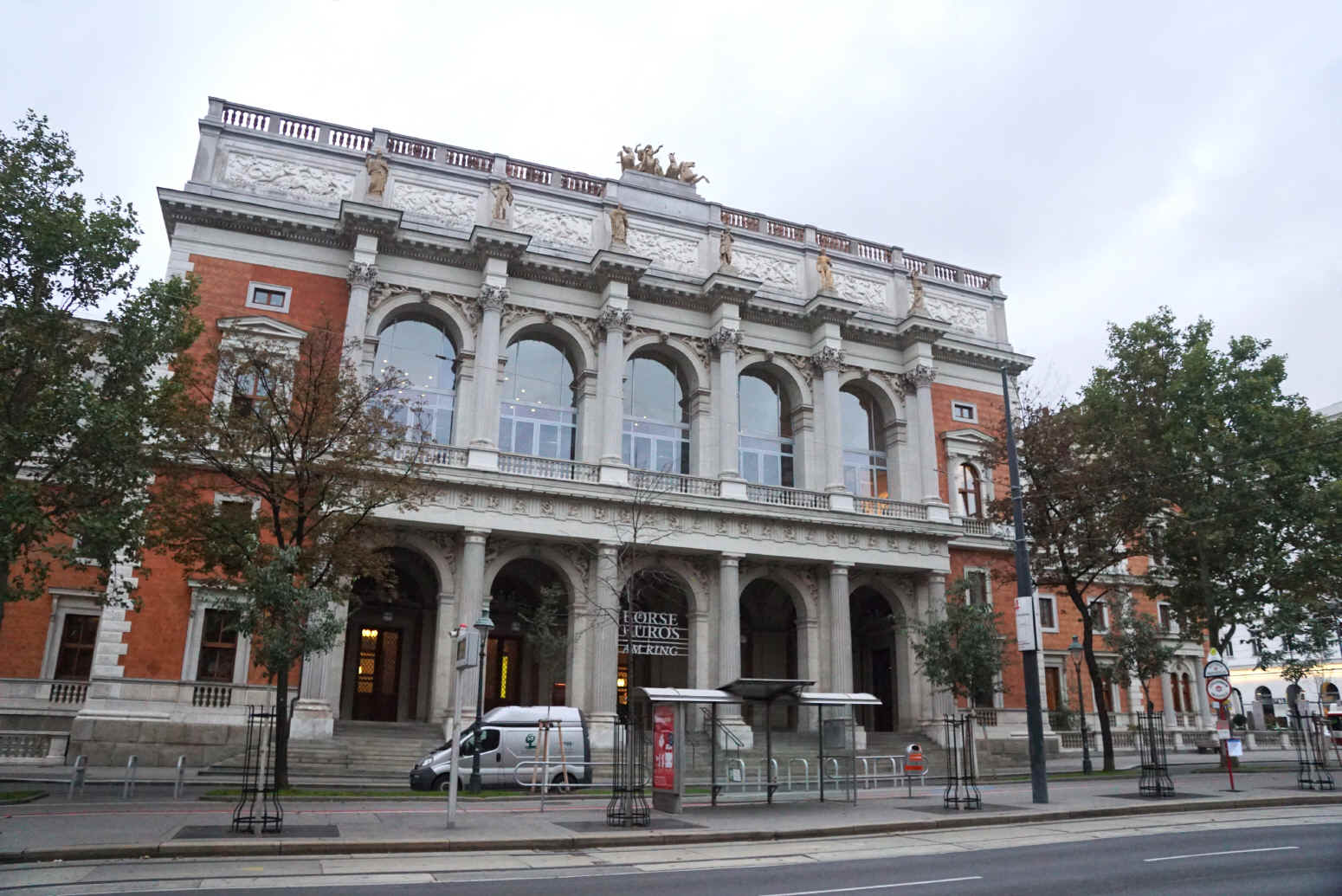
There
are those who claim to not like the Ring Street -- architectural purists, and
those who disapprove of massive, expensive buildings, saying the money could
have been spent in better ways. Maybe so, but it's there now, so we might
as well love it. Those purists are the ones who don't like buildings being
built in the styles of former centuries, saying that new buildings should be
built in the prevalent style of their era -- not in fake Gothic, Renaissance,
Greek, or Baroque styles from long ago. But if they had all been built in
the style of the late 1800's, as nice as that often was, then they would all
look rather alike instead of each one being radically distinctive. It is
the amazing contrast of all these buildings that is so effective, as you walk
around the Ring.
Click here for Page Two: Around the City